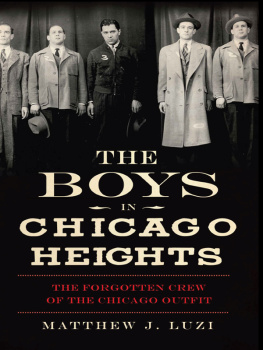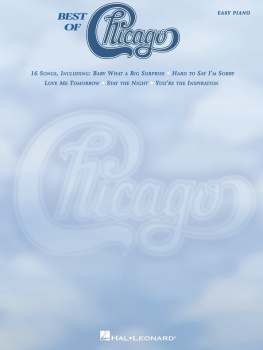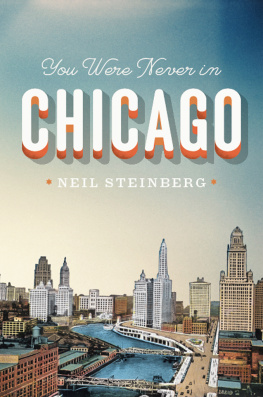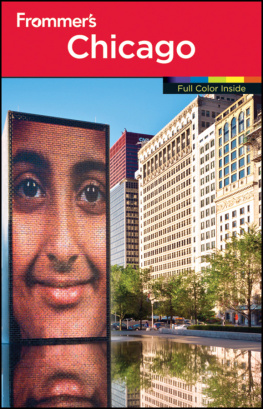
To the memory of my grandfather, John Luzi

John Luzi, on the right, bartending at the Club Cadillac on the Strip in Calumet City circa 1940.
Published by The History Press
Charleston, SC 29403
www.historypress.net
Copyright 2012 by Matthew J. Luzi
All rights reserved
Front cover: Collection of John Binder
First published 2012
e-book edition 2012
Manufactured in the United States
ISBN 978.1.61423.726.6
Library of Congress CIP data applied for.
print ISBN 978.1.60949.733.0
Notice: The information in this book is true and complete to the best of our knowledge. It is offered without guarantee on the part of the author or The History Press. The author and The History Press disclaim all liability in connection with the use of this book.
All rights reserved. No part of this book may be reproduced or transmitted in any form whatsoever without prior written permission from the publisher except in the case of brief quotations embodied in critical articles and reviews.
CONTENTS
ACKNOWLEDGEMENTS
I acknowledge and thank my wife, Christine, for her indulgence, and I acknowledge and thank all of my family members for their support and encouragement.
I am grateful to John Binder, Mark Levell, Jeff Thurston, Art Bilek and Chuck Schauer. I thank John for his generosity in always including me on information related to Chicago Heights and sharing his resources. Thanks to Mark for sharing his information and connecting me with several people that contributed to my understanding of this subject. Just when I thought that most resources were tapped out of information, Jeff Thurston seemed to come up with another obscurity that helped add context and background. Art Bileks firsthand knowledge of some of the people and places related to this subject was a great contribution. Chuck Schauer has been a great resource regarding the Thompson Submachine, not to mention a great theorist on the St. Valentines Day Massacre. I am also grateful to Mars Eghigian Jr. for directing me to certain resources and assisting in navigating various bureaucracies.
I am fortunate to have known several people that lived through some of the events described in this work. I am very appreciative that they took time to discuss their experiences with me. It was a pleasure to have known Rio Burke. I am extremely appreciative of the information she provided as Dominic Robertos former wife. It was also a pleasure to have known Joe Fushi. His firsthand knowledge of certain events and of the technical aspects of alcohol production was invaluable.
I would also like to acknowledge Lou Corsino. I am grateful to Lou for sharing his knowledge and information and especially for connecting me to a great bunch of guys from Chicago Heights.
Thanks to Dr. Jim Ammirati, Jim Ammirati and Mike Roberts for sharing information and photographs. Unless otherwise noted, all images appear courtesy of the author.
For anyone wishing to contact me about the boys in Chicago Heights, I may be reached at .
INTRODUCTION
Chicago Heights, Illinois, is a working class suburb situated about thirty-five miles south of the Loop, downtown Chicago. It was once a satellite city, together with Joliet, Aurora, Elgin and Waukegan. Chicago Heights grew out of farmland at the turn of the twentieth century. The community was originally planned and designed to attract businesses that desired to get away from the congestion and high costs of Chicago. The jobs created attracted emigrants from across Europe.
My own family followed the path to Chicago Heights. My great-grandfather, Ruggiero Luzi, emigrated from San Benedetto del Tronto, Italy. He arrived in Chicago Heights in 1916. My great-grandmother, Theresa Liparota, was from Sambiase, Calabria, Italy. She arrived in Chicago Heights in 1913 with her mother, sister and brother. The two met in Chicago Heights through the arrangement of Theresas father and were married in 1919. Originally they lived on the East Side of Chicago Heights and later moved to West End Avenue, just across the tracks that separate the East Side from the West Side.
I was curious about our family heritage. I asked questions and listened to stories about what it was like in Chicago Heights during the old days. It seemed that the experiences of my family were similar to those of most other immigrants. However, there were stories that I heard about bootleggers that I thought were unique. There were stories of my great-grandmother cooking for her brother, Frank Liparota (aka LaPorte), Dominic Roberto, Jim Emery and their friendsbig shots in the Syndicate. I also heard that Frank LaPorte sometimes harbored unsavory out-of-town characters at my great-grandparents house. Whenever these guests were present, the curtains and shades remained drawn to avoid the risk that someone might learn who was staying there. I heard about Al Capone coming to town and handing money out to children. I was told that Dominic Roberto, Jim Emery and Frank LaPorte were close to Al Capone. I also heard stories about Joliet, Illinois, and Calumet City, Illinois, during the 1940s and 50s.
Notwithstanding the stories, I had difficulty learning more because the history of Chicago Heights on this subject is often overlooked in resources. There are few references to Dominic Roberto and Jim Emery, if they are mentioned at all. Much of the history about Al Capone is recorded as if Al Capone was solely responsible for events that occurred during Prohibition across the Chicago metropolitan area. Likewise, events during Prohibition in Chicago Heights are attributed to Capone taking over bootlegging or establishing the practice. Later accounts of organized crime activities in Chicago Heights and the surrounding suburbs were attributed to Chicago Outfit bosses based in Chicago Heights. While true that by the early 1930s the Chicago Heights street crew was integrated with the Chicago Outfit, many accounts make it seem as though local bosses were transplanted from Chicago.
Federal agencies, mostly the Federal Bureau of Investigation (FBI), did not begin to investigate the Chicago Outfit until after the Apalachin, New York meeting of organized crime bosses in 1957. Prior to 1957, the FBI considered criminal organizations such as the Capone Gang to be local and therefore, outside its jurisdiction. When the FBI began to investigate organized crime, it paid little attention to the origins of the Outfit, except where it was relevant to note that the subject of an investigation was previously a member of the old Capone Gang. I suspected that Dominic Roberto, Jim Emery and Frank LaPorte played a more important role to Al Capone, and later the Outfit, than many accounts reported. Therefore, I decided to conduct some research of my own.
The information I discovered traces the origins of organized crime in Chicago Heights from before Prohibition and brings that history forward through its last known boss, Dominick Tootsie Palermo. The amount of information that I discovered is such that I am not able to record all of the details in this work. I am also unable to delve into the sociological questions about why organized crime flourished in Chicago Heights. Although some of the conditions described with respect to the neighborhoods in Chicago Heights and the conditions that many were forced to work in may provide some insight, a more in-depth analysis of the sociological questions deserve further exploration. However, this work is intended to reflect salient events in the history of the Chicago Heights street crew of the Outfit. Lets start by looking at the early days of Chicago Heights, including what attracted the Italians, where in Italy they came from and some of the events leading up to Prohibition.
Next page











